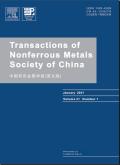还原熔炼法回收氰化尾矿中的多金属元素
IF 4.7
1区 材料科学
Q1 METALLURGY & METALLURGICAL ENGINEERING
Transactions of Nonferrous Metals Society of China
Pub Date : 2025-03-01
DOI:10.1016/S1003-6326(24)66728-2
引用次数: 0
摘要
提出了一种氰化尾矿处理工艺。该过程本质上涉及还原熔炼,包括在高温下挥发氰化尾矿中的银、铅和锌。同时,金和铜与还原的铁结合形成金属相,允许同时回收多金属元素。实验结果表明,在焦炭粉质量分数为7.5%、碱度为1.0、熔点为1450℃、熔点为60 min的条件下,生铁中金、铜、铁的溶出率分别达到99%以上、77%以上和94%以上。同时,银的挥发率超过90%,而铅和锌基本完全挥发。副产冶炼渣主要成分为阿角石,其浸出毒性低于国家标准,属于一般固体废物。并以铁对铜的捕集过程为例,系统考察了铁的捕集机理,将其分为熔炼还原、迁移捕集和凝结沉积三个过程。本文章由计算机程序翻译,如有差异,请以英文原文为准。
Recovery of polymetallic elements from cyanide tailings via reduction smelting
A process for treating cyanide tailings was proposed. The process essentially implicates reduction smelting which involves volatilizing silver, lead, and zinc in the cyanide tailings at high temperatures. Meanwhile, gold and copper combine with the reduced iron to form a metal phase, allowing for the simultaneous recovery of polymetallic elements. The experimental results indicate that the process works optimally with a coke powder of 7.5 wt.%, an alkalinity of 1.0, a melting temperature of 1450 °C, and a melting time of 60 min. Under these conditions, more than 99% of gold, 77% of copper and 94% of iron are incorporated into pig iron. In the meantime, the volatilization rate of silver exceeds 90%, while lead and zinc are essentially completely volatilized. The primary component of the by-product smelting slag is akermanite, which exhibits lower leaching toxicity than the national standard and belongs to general solid waste. Additionally, taking the trapping process of iron to copper as a case study, the mechanism of iron trapping is methodically examined and divided into three processes: smelting reduction, migration capture, and condensation deposition.
求助全文
通过发布文献求助,成功后即可免费获取论文全文。
去求助
来源期刊
CiteScore
7.40
自引率
17.80%
发文量
8456
审稿时长
3.6 months
期刊介绍:
The Transactions of Nonferrous Metals Society of China (Trans. Nonferrous Met. Soc. China), founded in 1991 and sponsored by The Nonferrous Metals Society of China, is published monthly now and mainly contains reports of original research which reflect the new progresses in the field of nonferrous metals science and technology, including mineral processing, extraction metallurgy, metallic materials and heat treatments, metal working, physical metallurgy, powder metallurgy, with the emphasis on fundamental science. It is the unique preeminent publication in English for scientists, engineers, under/post-graduates on the field of nonferrous metals industry. This journal is covered by many famous abstract/index systems and databases such as SCI Expanded, Ei Compendex Plus, INSPEC, CA, METADEX, AJ and JICST.

 求助内容:
求助内容: 应助结果提醒方式:
应助结果提醒方式:


